#philistis
Text
Friendly reminder Louis is performing here in 30 days.



Now since I’m a geek, let me rant about some ancient history and… 🥁 🥁 mythology! It never happens that international artists come to the South. This is huuuuuge for me and I am very proud (I don’t live in Sicily, I’m the friendly neighbour i guess, but I love it!).
Anyway.
The building dates back to III century b.C. Presumably the theater is of Hellenistic origin, as suggested by some stone blocks from Taormina and the inscriptions in Greek on some steps with the name of Philistis, wife of Hieron II and probable commissioner of the building, preserved in the western versure.
It was rebuild by the Emperor Augustus in the II a.C. and they used it for venationes, spectacles including gladiators fights against ferocious beasts. It was partially destroyed by the Vandals and later abandoned after the end of the roman empire.
The Theater has once again become a true protagonist with the romantic rediscovery linked to the Grand Tour. Starting from the XVII century, Taormina and above all its theater represent a must for every traveler who is passionate about history and culture. In 1978, Goethe visited the theatre and wrote a cute rec in one of his letters, describing the Theatre sublime for the decadency and the breathtaking view.
The viewpoints that the theater offers allow you to admire Etna Volcano and the bay of Naxos and Taormina to the south or the Calabrian coast with the Strait of Messina to the north. A spectacular natural setting. The scene partly retains its original form, thanks to a controversial nineteenth-century restoration. Two large side rooms (versurae) closed the stage and the stalls. Consisting of the steps, the auditorium has a diameter of 109 meters. It is subdivided into nine sectors or "wedges" by eight ladders and could hold at least 10,000 spectators (today 4,500).
Don’t let me even mention the acoustic. It’s gonna be sick, I promise you. These buildings were purposely built for theatrical acts. The actors used to speak without microphones and stereos. The geometry of the theatre allow the perfect resonance for the voices and instruments.
What we need is a cool fan project. Roses, laurels leaves, buttercups. White dress code, it’s theatre night after all 😌
#i dont know im not good with suggestions but that’s bacisally what I would do#imagineeeeeee#my little greek-latin obsessed me would be screaming crying#im gonna think to bring my laureal crown lmao#taormina teatro antico#louis in taormina#mini lour 22#im so excited for his tour in the south#this never ever happens#cant wait!#omfg louis
8 notes
·
View notes
Text

ÉTUDE BIBLIQUE~ÉSAÏE 14-16
👉Ésaïe 14:1-27
À cause de ses compassions pour le petit résidu de son peuple, Dieu renversera les plus grands empires (chapitre 43:3-5).
Rien n'est difficile pour Lui quand il s'agit de délivrer ceux qu'il aime. Ne craignons donc pas ! Il a en main tous les moyens de secourir ses enfants, non à cause de notre fidélité mais de la sienne.
Après Babylone, il est question de son roi. Et nous assistons à une scène particulièrement saisissante. Par la pensée, Ésaïe nous transporte dans le séjour des morts et imagine l'émoi causé par l'arrivée de ce grand personnage. Tiens ! Te voilà toi aussi, s'étonnent ceux qui l'auront connu au sommet de sa puissance (verset 9 à 11) !
Dans ce roi de Babylone, nous reconnaissons le chef du quatrième Empire (romain) appelé aussi « la Bête ». Cependant à partir du verset 12, la pensée de l'Esprit dépasse cet agent de Satan pour évoquer celui-ci même. « Comment es-tu tombé des cieux… ? ».
Profond mystère, que cette apparition de l'orgueil en Lucifer, le chérubin de lumière ! Devenu le prince des ténèbres, il sait encore, pour séduire, se déguiser en ange de lumière (2 Corinthiens 11:14). Il fait aujourd'hui trembler la terre par le pouvoir des ténèbres et ne relâche pas ses prisonniers (verset 17 et chapitre 49:24-25). Mais selon Sa promesse, Dieu le brisera bientôt sous nos pieds (Romains 16:20; Ézéchiel 28:16 à 19).
👉Ésaïe 14:28-32 ; 15:1-9 ; 16:1-14
Après le jugement contre Babylone et l'Assyrie (verset 24 à 27), vient celui des nations voisines d'Israël.
Comme des accusés qui se succèdent à la barre d'un tribunal, ces ennemis traditionnels du peuple juif vont entendre l'un après l'autre un solennel « oracle ». La Philistie subjuguée par Ozias, père d'Achaz (2 Chroniques 26:6) n'avait pas lieu de se réjouir de la mort de ce dernier (versets 28, 29). Car Ézéchias son fils allait lui aussi la frapper (2 Rois 18:8).
Moab est appelé « le très hautain » (Ésaïe 16:6). Ce qui caractérisait ce peuple, c'était l'orgueil, au sujet duquel l'Éternel déclare : « Je hais l'orgueil et la hauteur », et annonce : « L'orgueil va devant la ruine, et l'esprit hautain devant la chute » (Proverbes 8:13; 16:18).
Nous assistons à cette ruine de Moab. Sa désolation est indescriptible. Ses hurlements d'épouvante et de désespoir remplissent les chapitres 15 et 16.
Les versets 3 et 4 du chapitre 16 nous apprennent que les fidèles, fuyant la persécution de l'Antichrist en Juda, trouveront refuge sur le territoire de Moab.
Enfin, après l'exécution des jugements, « il y en aura un » qui règnera en bonté, en vérité, en droiture et en justice (chapitre 16:5).
Le Psaume 72:1-4 annonce ces temps heureux où Christ, le vrai Salomon, jugera le peuple en justice et avec droiture.
CAMP DE VÉRITÉ WHATSAPP :
+22962936838
#BIBLIQUEST #PAROLEDEDIEU #JÉSUS
#PARTAGEZ_LA_PUBLICATION
#ABONNEZ_VOUS_À_LA_PAGE
0 notes
Text
Dieu a parlé dans son temple saint: « Le vainqueur, c’est moi! Je vais partager la ville de Sichem, je vais mesurer la vallée de Soukoth. Galaad est à moi, Manassé est à moi. Éfraïm est un casque pour ma tête. Juda est mon bâton de commandement. Moab est la cuvette où je me lave, je pose le pied sur Édom pour le prendre. Contre la Philistie, je pousse un cri de guerre. » Avec Dieu, nous remporterons la victoire: c’est lui qui écrasera nos ennemis.
Psaumes 60:8-10, 14
0 notes
Photo



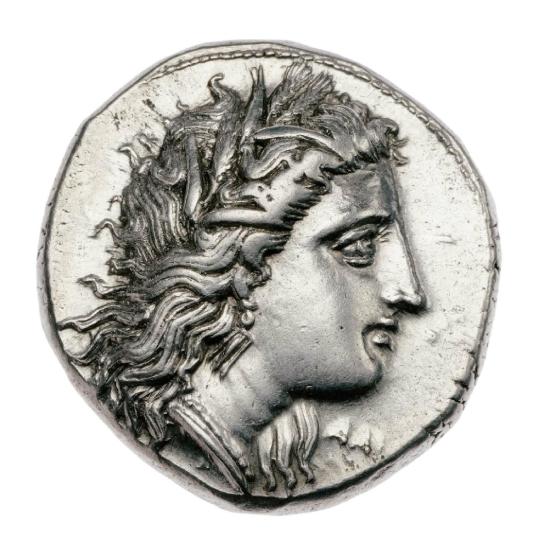
It is easy to forget just how detailed and characterful the portraits on Greek coins could be...
#portrait#coin#numismatics#ancient greece#ancient history#kore#athena#perseophone#philistis#tagamemnon#ancientart#art#detail#character#hairstyle#silver
1K notes
·
View notes
Photo
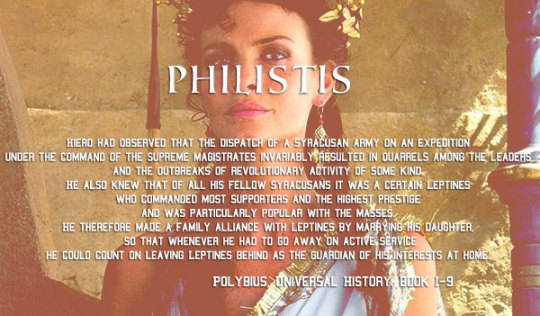
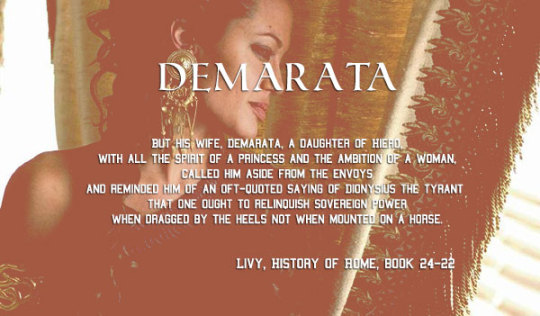
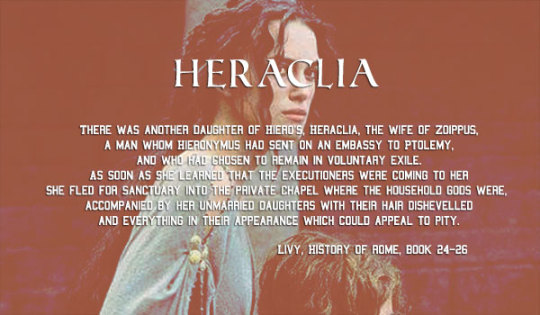
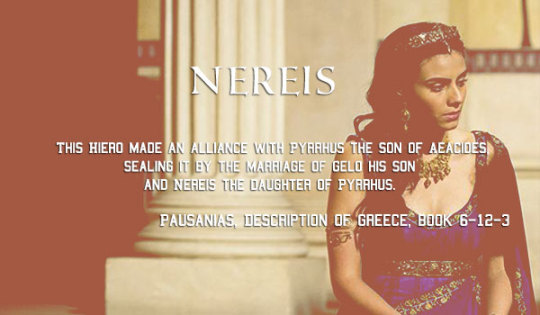
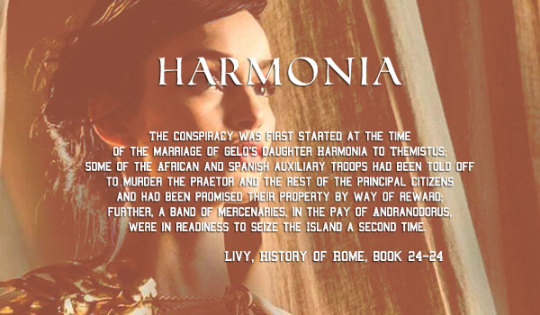
"For what," he [the praetor Sopater] asked, "could a boy like Hieronymus, who was hardly in his teens, have done on his own initiative? His guardians and masters reigned unmolested because the odium fell on another; they ought to have perished before Hieronymus or at all events when he did. [...] But it was really the wives who were responsible and who, being of royal blood, had filled their husbands with a passion for royalty, for one of the men had married Hiero's daughter, the other a daughter of Gelo." At these words shouts rose from the whole assembly declaring that neither of these women ought to live, and that no single member of the royal family ought to survive.
Livy, History of Rome, book 24-24
The Women of the House of Hiero II of Syracuse (3rd century BC)
Philistis was the daughter of an influential Syracusan citizen, Leptines. Through her father, she descended from Siceliot historian Philistus. Around 275 BC Philistis married Hiero, who will become tyrant of Syracuse in 270 BC. This man was the illegitimate son of a Syracusan nobleman, Hierocles. Hiero served under Pyrrhus I of Epirus during the Sicilian campaign, and after the King of Epirus left the Island, Hiero was appointed arcontes together with another man, Artemidorus. While the latter, at some point, simply disappeared from the chronicles, Hiero managed to establish a personal rule resembling the contemporary Hellenistic reigns. Philistis would give birth to three children: Gelo, Demarata and Heraclia. Nothing more is known about her life or death, although she’s portrayed in various coins minted during the reign of her husband. In these coins Philistis appears veiled and with idealized traits, resembling the type of Demeter, but also in the style of the coins of the Ptolemaic queens of Egypt.
Demarata was daughter of Hiero II and Philistis. Her name was chosen to honor late queen Demarete of Syracuse and in an attempt to link Hiero’s dinasty to previous tyrant Gelon’s, from whom Hiero declared to descend. Demarata married Adranodoros, one of Hieronymus’ fifteen guardians and part of the pro-Carthaginian faction. Hieronymus was Hiero’s grandson and heir as well as Demarata’s nephew and became Syracuse’s tyrant after his grandfather’s death in 215 BC. Taking advantage of his nephew’s young age (he was 15 at that time), Adranodoros concluded an alliance between Syracuse and Carthage, thus betraying Rome. Moreover he dismissed the other guardians and became Hieronymus’ sole ward with the title of chief counsellor. Hieronymus was killed (stabbed to death) in 214 BC in Leontini by a band of conspirators led by the Syracusan Deinomenes. He had ruled for just 13 months. At first, Adranodoros attempted to seize the power and become the new tyrant. When he understood it was too difficult and risky, he surrendered the power to the Syracusan people and was appointed general. But soon the people became wary of Adranodoros, especially after Ariston, a comedian and friend of the general, declared that Adranodoros and Themistos (brother-in-law of the late Hieronymus) were plotting to massacre the other influential citizens to establish their personal tiranny. Syracusan senate then gave order to eliminate the threat and so Adronodoros and Themistus were killed as soon as they entered the Senate building in 214 BC. Not satisfied with just those two murders and with the intent to justify his decision, the other general Sopater (member of the pro-Roman faction) accused the two men’s wives. In particular, Demarata was depicted as ambitious and power-hungry. She was accused of being the real mastermind behind the idea to remove Hieronymus’ other guardians, as a matter of fact starting Adranodoros’ scramble for power. Demarata’s supposed (or not) aspiration to become Syracuse’s queen was shattered the moment she was killed by the angry mob incited by Sopater’s accusations.
Heraclia was daughter of Hiero II and Philistis, as well as sister of Demarata and Gelo. She married Zoippus, who together with Adranoros was one of his nephew Hieronymus’ guardians. Like his brother-in-law, Zoippus was part of the pro-Carthaginian faction and worked to distance Syracuse from Rome. He was sent to a diplomatic mission to Ptolemy (most certainly Ptolemy IV Philopator). When in 214 BC Zoippus was reached by the news of Hieronymus’ death, he decided to remain in Alexandria in a self-imposed exile and so he survived his family’s massacre. His wife, Heraclia, and his two unnamed daughters weren’t equally lucky. No importance was given to the fact they were extraneous of plots and political schemes, what mattered was they were members of the royal family. They seeked refuge in a temple, hoping the mob would have respected the sacrality of the place. Heraclia implored the crowd to at least spare the girls, who were so young and innocent and just kill her. She was dragged outside the temple and killed before her daughters’ eyes with her blood splattering them. The girls, at first, managed to resist, but in the end they fell lifeless to the ground with their bodies full of wounds and whole place was covered in their blood. Soon after a messenger arrived with the order they were not to be killed, but it was already too late.
Nereis was an Epirote princess and the daughter of Pyrrhus II of Epirus and an unnamed woman. Her sister Deidameia was the last Aeacid sovereign of Epirus. Nereis descended from both Pyrrhus I of Epirus (her great-grandfather) and the Syracusan tyrant Agathocles (her great-great-grandfather). Her marriage to Gelo, Hiero’s son, was part of her father-in-law’s policy to strenghten and validate his dynasty. A similar alliance had been established in the past, and Nereis was the result of it. The marriage pact was concluded just before the fall of the Aeacid dynasty. The princess bore at least two children to Gelo, a girl and a boy: Harmonia and Hieronymus. Nothing is known about her fate, but it’s implied she survived her sister, making Nereis the last surviving Aeacid royal member.
Harmonia was the only daughter of Gelo of Syracuse and Nereis of Epirus. This made her the granddaughter and then the sister of the last two Syracusan tyrants. She married Themistos, member of the pro-Carthaginian faction and possibly one of the 15 guardians of Hieronymus. Themistos was accused together with Adranodoros to aspire to a personal tyranny following the murder of his brother-in-law and then killed. Like her aunt Demarata, Harmonia was considered a schemer and a puppetmaster of both her husband and young brother. After the murders of her aunts and cousins, it was only a matter of time Harmonia would have followed them. Her nurse then found a girl of the same age and resembling her protegée. The girl accepted to pass off the princess and was dressed in royal attire by the nurse, then she proceded to draw all the attention to her. In the meantime, Harmonia went hiding, but seeing the murderous crowd killing the innocent girl was too much for the princess. Tradition says she killed herself, although according to Valerius Maximus she revealed herself in front of the killers, claiming to be the real Harmonia, and was instantly murdered.
#women#history#women history#historical women#sicily#Philistis#Demarata#Heraclia#Nereis#Harmonia#hiero ii of syracuse#hieronymus of syracuse#greek sicily#people of sicily#women of sicily#siracusa#province of siracusa#historyedit#myedit
64 notes
·
View notes
Text
l’Évangile au Quotidien
l’Évangile au Quotidien
« Seigneur, vers qui irions-nous ? Tu as les paroles de la vie éternelle » Jn 6, 68
Mardi 28 Septembre
Livre de Zacharie 8,20-23.
Ainsi parle le Seigneur de l’univers : Voici que, de nouveau, des peuples afflueront, des habitants de nombreuses villes.
Les habitants d’une ville iront dans une autre ville et diront : « Allons apaiser la face du Seigneur, allons chercher le Seigneur de l’univers ! Quant à moi, j’y vais. »
Des peuples nombreux et des nations puissantes viendront à Jérusalem chercher le Seigneur de l’univers et apaiser sa face.
Ainsi parle le Seigneur de l’univers : En ces jours-là, dix hommes de toute langue et de toute nation saisiront un Juif par son vêtement et lui diront : « Nous voulons aller avec vous, car nous avons appris que Dieu est avec vous. »
Psaume 87(86),1-3.4-5.6-7.
Elle est fondée sur les montagnes saintes.
Le Seigneur aime les portes de Sion
plus que toutes les demeures de Jacob.
Pour ta gloire on parle de toi, ville de Dieu !
« Je cite l'Égypte et Babylone
entre celles qui me connaissent. »
Voyez Tyr, la Philistie, l'Éthiopie :
chacune est née là-bas.
Mais on appelle Sion : « Ma mère ! »
car en elle, tout homme est né.
C'est lui, le Très-Haut, qui la maintient.
Au registre des peuples, le Seigneur écrit :
« Chacun est né là-bas. »
Tous ensemble ils dansent, et ils chantent :
« En toi, toutes nos sources ! »
Évangile de Jésus-Christ selon Luc 9,51-56.
Comme s’accomplissait le temps où il allait être enlevé au ciel, Jésus, le visage déterminé, prit la route de Jérusalem.
Il envoya, en avant de lui, des messagers ; ceux-ci se mirent en route et entrèrent dans un village de Samaritains pour préparer sa venue.
Mais on refusa de le recevoir, parce qu’il se dirigeait vers Jérusalem.
Voyant cela, les disciples Jacques et Jean dirent : « Seigneur, veux-tu que nous ordonnions qu’un feu tombe du ciel et les détruise ? »
Mais Jésus, se retournant, les réprimanda.
Puis ils partirent pour un autre village.
© AELF, Paris
« Il prit avec courage la route de Jérusalem »
Le Christ est le chemin et la porte (Jn 14,6; 10,7), l'échelle et le véhicule (...), « le mystère caché depuis le commencement » (Mt 13,35). Celui qui tourne résolument et pleinement ses yeux vers le Christ en le regardant suspendu à la croix, avec foi, espérance et charité, dévotion, admiration, exultation, reconnaissance, louange et jubilation, celui-là célèbre la Pâque avec lui (cf Mc 14,14), c'est-à-dire se met en route pour traverser la mer Rouge grâce au bâton de la croix (cf Ex 14,16). (...) En cette traversée, si l'on veut être parfait, il importe de laisser là toute spéculation intellectuelle. Toute la pointe du désir doit être transportée et transformée en Dieu. Voilà le secret des secrets, que « personne ne connaît sauf celui qui le reçoit » (Ap 2,17), que nul ne reçoit sauf celui qui le désire, et que nul ne désire sinon celui qui est enflammé par l'Esprit Saint que le Christ a envoyé sur la terre. C'est pour cela que l'apôtre Paul dit que cette mystérieuse sagesse est révélée par l'Esprit Saint (1Co 2,10).
Si tu recherches comment cela se produit, interroge la grâce et non le savoir (...), l'obscurité et non la clarté, non point ce qui luit mais le feu qui embrase tout l'être et le transporte en Dieu avec une onction sublime et un élan plein d'ardeur. Ce feu est en réalité Dieu lui-même dont « la fournaise est à Jérusalem » (Is 31,9). C'est le Christ qui l'a allumé dans la ferveur brûlante de sa Passion. (...) Celui qui aime cette mort de la croix peut voir Dieu ; car elle ne laisse aucun doute, cette parole de vérité : « L'homme ne peut me voir s'il ne cesse de vivre » (Ex 33,20).
Mourons donc, entrons dans l'obscurité, imposons silence à nos soucis, à nos convoitises et à notre imagination. Passons avec Jésus crucifié « de ce monde au Père » (Jn 13,1). Et quand le Père se sera manifesté, disons avec Philippe : « Cela nous suffit » (Jn 14,8) ; écoutons avec Paul : « Ma grâce te suffit » (2Co 12,9) ; exultons en disant avec David : « Ma chair et mon cœur peuvent défaillir : le roc de mon cœur et mon héritage, c'est Dieu pour toujours » (Ps 72,26).
0 notes
Video
youtube
Lion Of Judah / Prophetic Warfare Music by Kyle Lovett - (Shofar, tambours)
Eternel des Armées - Yahweh Sabaoth - Yahveh Tsebaoth
Blog de Kyle Lovett : Warfare and worship music
♥ Musique ointe ♥
It’s time to sound the Alarm and pray with Fasting, repent and supplication !
Prepare the way of the Lord !
Il est temps de sonner l’alarme et de prier avec le jeûne, le repentir et la supplication !
Préparez la voie du Seigneur !
L’armée céleste est positionnée et est prête à combattre.
Qui parmi le peuple d’Elohim est en ordre de marche ?
Qui est prêt à se lever et à rentrer dans son Appel ?
Qui est prêt pour le combat, le VRAI COMBAT SPIRITUEL ?
“ Alors Moïse et les Israélites entonnèrent ce cantique en l’honneur de l’Eternel :
Je veux chanter pour l’Eternel, il a fait éclater sa gloire, il a culbuté dans la mer le cheval et son cavalier.
L’Eternel est ma force, il est le sujet de mes chants, il m’a sauvé, il est mon Dieu, je le louerai et je l’exalterai, lui, le Dieu de mon père.
L’Eternel est un grand guerrier, l’Eternel est son nom.
Les chars du pharaon et toute son armée, il les a jetés à la mer, l’élite de ses combattants a été engloutie dans la mer des Roseaux, et les flots les ont recouverts.
Ils ont coulé comme une pierre dans les profondeurs de l’abîme.
Ton bras droit, Eternel, a fait éclater sa puissance, ton bras droit, Eternel, écrase l’ennemi.
Dans ta gloire éclatante, tu renverses tes adversaires, tu déchaînes contre eux le feu de ta colère et ils sont consumés comme des brins de paille.
Sous l’action de ton souffle, les eaux se sont amoncelées, les flots se sont dressés comme un rempart, et ils se sont figés au milieu de la mer.
L’ennemi se disait :
Je les pourchasserai et je les atteindrai, je m’emparerai d’un butin, je m’en rassasierai, je tirerai l’épée, je me saisirai d’eux.
Tu as soufflé, et la mer les a recouverts !
Ils se sont enfoncés comme des blocs de plomb dans les puissantes eaux.
Qui, parmi tous les dieux, ô Eternel, qui est semblable à toi ?
Et qui est, comme toi, paré de sainteté, et redoutable, et digne de louanges, opérant des prodiges ?
Tu étends ton bras droit, et la terre engloutit nos poursuivants.
Dans ton amour, tu as conduit ce peuple que tu as libéré et tu l’as dirigé par ta grande puissance vers ta demeure sainte.
Les peuples l’ont appris et ils en ont tremblé.
La terreur a saisi les gens de Philistie.
Déjà les chefs d’Edom en sont épouvantés, les princes de Moab se mettent à trembler, tous les Cananéens en perdent le courage.
L’angoisse et la panique s’abattent sur eux tous.
Ton action extraordinaire les a tous pétrifiés, jusqu’à ce qu’ait passé ton peuple, ô Eternel ! Jusqu’à ce qu’ait passé ce peuple que tu t’es acquis.
Tu les amèneras et tu les planteras sur la montagne qui t’appartient, au lieu que tu destines à être ta demeure, ô Eternel, jusqu’à ton sanctuaire, ô Eternel que tes mains ont fondé.
L’Eternel régnera à perpétuité !
En effet, les chevaux du pharaon, ses chars et ceux qui les montaient s’étaient engagés dans la mer, et l’Eternel avait fait refluer l’eau sur eux tandis que les Israélites avaient traversé la mer à pied sec.
Miryam, la prophétesse, sœur d’Aaron, prit le tambourin, et toutes les femmes la suivirent en dansant et en jouant des tambourins.
Miryam entonna, en réponse aux Israélites : Chantez pour l’Eternel : il a fait éclater sa gloire, il a culbuté dans la mer le cheval et son cavalier. “ (Exode 15:1-21 : Le cantique de délivrance - Cantique de Moïse et d’Israël)
“ Que tu es heureux, Israël ! Qui est comme toi, Un peuple sauvé par YHWH, le bouclier de ton secours et l'épée de ta gloire ?
Tes ennemis feront défaut devant toi, Et tu fouleras leurs lieux élevés.” (Deutéronome 33:29)
“ Tu sauves le peuple qui s'humilie, et de ton regard, tu abaisses les orgueilleux. Oui, tu es ma lumière, ô Eternel!
L'Eternel éclaire mes ténèbres.
Avec toi je me précipite sur une troupe en armes, avec mon Elohim je franchis une muraille. “ (Deutéronome 33:29)
“ Oui, tu fais briller ma lumière; L'Eternel, mon Dieu, éclaire mes ténèbres. Avec toi je me précipite sur une troupe en armes, Avec mon Dieu je franchis une muraille.
Les voies de Dieu sont parfaites,
La parole de l'Eternel est éprouvée;
Il est un bouclier pour tous ceux qui se confient en lui.
Car qui est Dieu, si ce n'est l'Eternel;
Et qui est un rocher, si ce n'est notre Dieu?
C'est Dieu qui me ceint de force, Et qui me conduit dans la voie droite. “ (Psaume 18:28-32)
“ Psaume d'Asaph.
Elohim, Elohim, YHWH, parle, et CONVOQUE LA TERRE,
Depuis le soleil levant jusqu'au soleil couchant.
De Sion, beauté parfaite, Dieu resplendit.
Il vient, notre Dieu, il ne reste pas en silence;
Devant lui est un feu dévorant, Autour de lui une violente tempête.
Il crie vers les cieux en haut, et vers la terre, pour juger son peuple:
* RASSEMBLEZ-MOI LES FIDELES, QUI ONT FAIT ALLIANCE AVEC MOI PAR LE SACRIFICE ! *
Et les cieux publieront sa justice, car c'est Dieu qui est juge. " (Psaume 50:1-6)
“ Je t'exalterai, mon Dieu, mon Roi, je bénirai ton nom toujours et à jamais !
Chaque jour je te bénirai, je louerai ton nom toujours et à jamais.
Il est grand, le Seigneur, hautement loué ; à sa grandeur, il n'est pas de limite.
D'âge en âge, on vantera tes œuvres, on proclamera tes exploits.
Je redirai le récit de tes merveilles, ton éclat, ta gloire et ta splendeur.
On dira ta force redoutable ;
je raconterai ta grandeur.
On rappellera tes immenses bontés ; tous acclameront ta justice.
Le Seigneur est tendresse et pitié, lent à la colère et plein d'amour ;
la bonté du Seigneur est pour tous, sa tendresse, pour toutes ses œuvres.
Que tes œuvres, Seigneur, te rendent grâce et que tes fidèles te bénissent ! Ils diront la gloire de ton règne, ils parleront de tes exploits, annonçant aux hommes tes exploits, la gloire et l'éclat de ton règne : ton règne, un règne éternel, ton empire, pour les âges des âges.
Le Seigneur est vrai en tout ce qu'il dit, fidèle en tout ce qu'il fait.
Le Seigneur soutient tous ceux qui tombent, il redresse tous les accablés.
Les yeux sur toi, tous, ils espèrent : tu leur donnes la nourriture au temps voulu ; tu ouvres ta main : tu rassasies avec bonté tout ce qui vit.
Le Seigneur est juste en toutes ses voies, fidèle en tout ce qu'il fait.
Il est proche de ceux qui l'invoquent, de tous ceux qui l'invoquent en vérité.
Il répond au désir de ceux qui le craignent ; il écoute leur cri : il les sauve.
Le Seigneur gardera tous ceux qui l'aiment, mais il détruira tous les impies.
Que ma bouche proclame les louanges du Seigneur !
Son nom très saint, que toute chair le bénisse toujours et à jamais ! “ (Psaume 144:1-15)
“ Puis je vis dans le ciel un autre signe, grand et admirable: sept anges, qui tenaient sept fléaux, les derniers, car par eux s'accomplit la colère d’Elohim. Et je vis comme une mer de verre, mêlée de feu, et ceux qui avaient vaincu la bête, et son image, et le nombre de son nom, debout sur la mer de verre, ayant des harpes d’Elohim.
Et ils chantent le cantique de Moïse, le serviteur de Dieu, et le cantique de l'agneau, en disant:
Tes œuvres sont grandes et admirables, Seigneur Dieu tout-puissant !
Tes voies sont justes et véritables, roi des nations !
Qui ne craindrait, Seigneur, et ne glorifierait ton nom ?
Car seul tu es saint. Et toutes les nations viendront, et se prosterneront devant toi, parce que tes jugements ont été manifestés. “ (Apocalypse 15:1-4)
0 notes
Photo

1 Chronicles 11 David Becomes King Over Israel 11 All Israel came together to David at Hebron and said, “We are your own flesh and blood. 2 In the past, even while Saul was king, you were the one who led Israel on their military campaigns. And the Lord your God said to you, ‘You will shepherd my people Israel, and you will become their ruler.’” 3 When all the elders of Israel had come to King David at Hebron, he made a covenant with them at Hebron before the Lord, and they anointed David king over Israel, as the Lord had promised through Samuel. David Conquers Jerusalem 4 David and all the Israelites marched to Jerusalem (that is, Jebus). The Jebusites who lived there 5 said to David, “You will not get in here.” Nevertheless, David captured the fortress of Zion—which is the City of David. 6 David had said, “Whoever leads the attack on the Jebusites will become commander-in-chief.” Joab son of Zeruiah went up first, and so he received the command. 7 David then took up residence in the fortress, and so it was called the City of David. 8 He built up the city around it, from the terraces[a] to the surrounding wall, while Joab restored the rest of the city. 9 And David became more and more powerful, because the Lord Almighty was with him. David’s Mighty Warriors 10 These were the chiefs of David’s mighty warriors—they, together with all Israel, gave his kingship strong support to extend it over the whole land, as the Lord had promised— 11 this is the list of David’s mighty warriors: Jashobeam,[b] a Hakmonite, was chief of the officers[c]; he raised his spear against three hundred men, whom he killed in one encounter. 12 Next to him was Eleazar son of Dodai the Ahohite, one of the three mighty warriors. 13 He was with David at Pas Dammim when the Philistines gathered there for battle. At a place where there was a field full of barley, the troops fled from the Philistines. 14 But they took their stand in the middle of the field. They defended it and struck the Philistines down, and the Lord brought about a great victory. 15 Three of the thirty chiefs came down to David to the rock at the cave of Adullam, while a band of Philisti https://www.instagram.com/p/B3XUEXHFM9z/?igshid=vaih1p1gi1e0
0 notes
Text
Guide to Ancient Greek Coins of Sicily Examples on VIDEO
Ancient Coins of Sicily Explained in Video & Article
Learn about the rare Sicilian ancient Greek coins and the cities that struck them
youtube
https://www.youtube.com/watch?v=petOafNL7D0
A list of all the ancient Greek cities in Sicily which minted coins with examples of them.
The ancient Greek Island of Sicily has a variety of history and amazing coins to explore. Some of the cities had some of the rarest coins possible. The best standard reference work on the subject of these coins is Handbook of Coins of Sicily by Oliver D. Hoover. I cite coins from this book quite often, as HGC 2, (and the coin number). It is full of history and a variety of types not usually seen anywhere. I highly recommend it.
Over the years I have had a collection of thousands of ancient Greek and Roman coins that is over 13,000 items now. This inventory includes some very rare coins from many cities of Sicily.
Some common problems with rare ancient coins in general are:
People don’t know exactly what to search for.
There are limited amounts of ancient coins available.
There is not a lot of information that can help a beginner collect this series.
There is usually not one source that has many of the rare types available.
This article is to provide people with solutions to this issue. My name is Ilya Zlobin, and I am an expert, enthusiast, author and dealer in ancient Greek Roman Byzantine and even world coins and medals. The reason for this article is that I believe an educated customer is the best customer, as only someone that knows about a specific subject can appreciate the value and beauty of it. I have many articles and videos on many subjects, teaching about different ancient coins. It took me years of experience to have the inventory I have available for you to explore. When you deal with me, you are leveraging my vast experience of working with over 53,000 items over the years.
This article is full of links to the specific coins and cities and the coins shown here are ones available in my eBay store at the time of the writing of this article. You can use the links to search my store for the specific items, of which I have many. Some links may or may not yield results, but may in the future. So in other words you can use this list in order to put together a collection, or check back at later dates for certain cities. You city names are quite hard sometimes to spell so it is another way it is really helpful.
Click here to see all coins of ancient Sicily I have available.
A List of the Cities that Issued Coins in Ancient Sicily
This list of ancient Sicilian cities is comprehensive, including some of the super rare mints which are usually not seen. If you decide to put together a collection, you can click on each of the cities below of your interest and search my eBay store with over 14,000 items for those specific coins. You can also use the list below for your own searches.
Abakainon
Adranon
Agyrion
Aitna
Akragas
Akrai
Alaisa Aitnai
Alaisa Archonidea
Alontion
Ameselon
Amestratos
Apollonia
Assoros
Ath Athl
Entella (“The Camp”)
Eryx
Galaria
Gela
Henna (Enna)
Herakleia Minoa
Herbessos
Herbita
Himera
Hipana
Hybla Megala (Hybla Geleatis)
Iaiton (Iaitia)
Imachara
Kainon
Kalakte (Kale Akte)
Kamarina
Katane
Kentoripai
Kephaloidion
Kimissa
Kronia
Leontinoi
Lilybaion
Longane
Megara Hyblaia
Menainon (Menaion)
Messana (Zankle) and the Mamertini
Morgantina
Motya
Mytistraton
Nakone
Naxos
Panormos (Sys)
Paropos
Petra
Piakos
Segesta (Egesta)
Selinous
Sergitaians
Solous
Sielane (Stiela)
Syracuse
Kings:
Agathokles (Agathocles)
Hieron II, Philistis, and Gelon II
Hieronymos
Tauromenion
Thermai Himeraiai
Tyndaris
The Tyrrhenians
The island of Lipara
or Explore all coins of Sicily

AITNA in SICILY after 210BC Ancient Greek City Coin Apollo Warrior i37922 Rare
Greek city of Aitna in Sicily
Bronze 18mm (3.38 grams) after 210 B.C.
Reference: Sear 1018 var. (three dot in field to left and head left); Calciati III, S. 148, Em. 8
Radiate bust of Apollo right, wearing chlamys.
AITNAIΩN, Warrior standing facing, head right, holding spear and shield; three pellets in field to left.
The Syracusan colonists expelled from Katane in 461 B.C. founded a new settlement about ten miles to the north-west, ad to this place they transferred the name of Aitna which they had previously bestowed upon Katane.
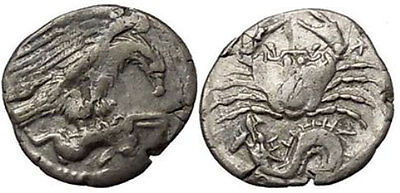
AKRAGAS in SICILY 420BC Hemidrachm Crab Hare Eagle Ketos Fish Silver Coin i40761
Greek city of Akragas in Sicily
Silver Hemidrachm 15mm (1.84 grams) Struck circa 420-406 B.C.
Reference: HGC 2, 105; SNG ANS 1010–3
Eagle standing right on hare; barley grain to left.
Crab; below, ketos left with fish in its mouth.

SICILY city AKRAI 210BC Underworld queen Demeter Cult Ancient Greek Coin i28403
Greek city of Akrai in Sicily
Bronze 22mm (9.01 grams) After 210 B.C.
Reference: Sear 1014; Calciati III pg. 37, 1; SNG ANS 902ff
Wreathed head of Persephone right.
AKPAIΩN, Demeter standing left, holding torch and sceptre.

ALONTION in SICILY 400BC Hercules Club Quiver Ancient Greek Coin i41711
Greek city of Alontion in Sicily
Bronze 15mm (2.63 grams) Struck circa 400 B.C.
Reference: CNS 6; SNG ANS 1193
Bearded head of Hercules right.
ΑΛΟΝΤΙNON, Club and quiver.
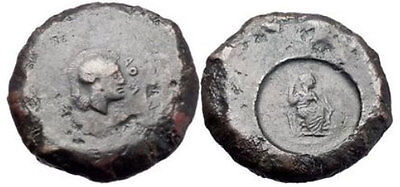
Athl / Atl / AΘA Mint in SICILY Rare 340BC Athena Rare Ancient Greek Coin i47252
Greek city or town Athl / Atl / AΘA Mint in Northwestern Sicily
Bronze 30mm (26.95 grams) Struck circa 340-330 B.C.
Reference HGC 2, 232; CNS III, p. 287, no. 1
AΘA, Head of Athena in Attic helmet right.
Female figure enthroned right, holding palm branch or scepter and grounded bow; all within incuse circle.
Numismatic Note: This mint’s name has been previously misread as AΘΛ (Athl), in light of modern numismatic scholarship, AΘA is actually a Doric abbreviation for Athena. So therefore, the name of this mint is unknown. What is known is that the larger bronzes were re-struck on Syracusan issues from the period of 375-345 B.C.

ERYX Sicily 400BC Female & Crab Rare Authentic Ancient Greek Coin i28255
Greek city of Eryx in Sicily
Bronze 11mm (1.56 grams) Struck circa 400-330 B.C.
Reference: Calciati I pg. 288, 28 var.; Gabrici pg. 131, 46-48
Female head right.
Crab.
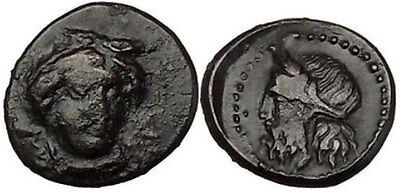
Gela in Sicily 339BC Rare Ancient Greek Coin Demeter River god Gelas i41739
Greek city of Gela in Sicily
Bronze 15mm (2.90 grams) Struck circa 339-310 B.C.
Reference: Sear 1099; Jenkins 549; B.M.C. 2.77-8
ΓΕΛΩΙΩΝ, Head of Demeter three-quarter face to right, wreathed with corn.
Bearded head of river-god Gelas left, horned, and wreathed with horn.
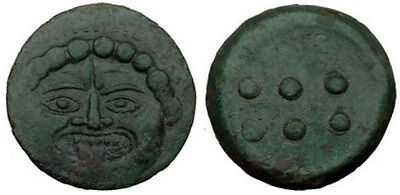
HIMERA Greek city in SICILY 420BC Hemilitron Large Ancient Coin Gorgon i37118
Greek city of Himera in Sicily
Bronze Hemilitron 24mm (15.98 grams) Struck circa 450-420 B.C.
Reference: Sear 1105; B.M.C. 2.,p.39,27-30
Gorgon’s head facing.
Six pellets.
Numismatic Note: Fantastic coin in the most fantastic condition you can find, especially such a rarity!
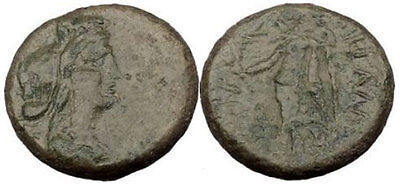
Hybla Megala in Sicily 210BC Hyblaia Modius Dionysus Panther Greek Coin i38058
Greek City of Hybla Megala in Sicily
Bronze 19mm (7.30 grams) After 210 B.C.
Reference: Sear 1115; Calciati III pg. 41, 1; SNG ANS 195ff
Veiled head of Hyblaia right, wearing modius; behind, bee.
ΥΒΛΑΣ ΜΕΓΑΛΑΣ, Dionysus standing left, holding kantharos and scepter, panther leaping up at feet.
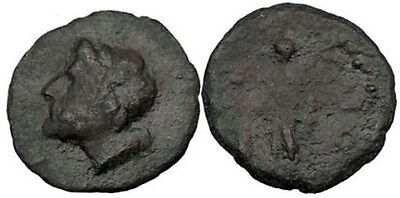
Iaitia in Sicily 241BC Zeus Hercules Authentic Ancient Greek Coin RARE i38057
Greek City of Iaitia in Sicily
Bronze 17mm (2.26 grams) After 241 B.C.
Reference: BMC – . SNG Cop. 333 var. SNG ANS – . SNG München – . Calciati I, S. 384, 6
Laureate head of Zeus left.
IAITOY, Hercules
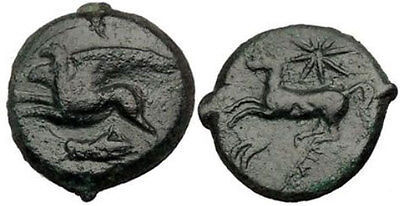
Alaisa “Kainon” in Sicily 360BC Rare Ancient Greek Coin Griffin Horse i43976
Greek city of Alaisa ” Kainon” in Sicily
Bronze 23mm (8.72 grams) Struck 360-340 B.C.
Reference: Calciati I pg. 252, 10; SNG ANS 1175ff
Griffin running left; grasshopper below.
Horse prancing left, reins loose; star above, KAINON in exergue.

Kamarina in Sicily 413BC Authentic Ancient Greek Coin OWL Athena i46586
Greek city of Kamarina in Sicily
Bronze Trias 15mm (3.36 grams) Struck 413-405 B.C.
Reference: Sear 1063; B.M.C. 2.40
Head of Athena left, in crested helmet ornamented with wing.
KAMA – Owl standing left, head facing, holding lizard in right claw; in exergue, three pellets.

Katane in Sicily 413BC Ancient Greek Coin River god Winged thunderbolt i37312
Greek city of Katane in Sicily
Bronze 12mm (1.93 grams) Struck 413-404 B.C.
Reference: Sear 1067; Gabrici (La monetazione del bronzo nella Sicilia antica), pl. 2,7
AMENANOΣ, Horned head of young river-god Amenanos left.
Winged thunderbolt dividing small K – A.
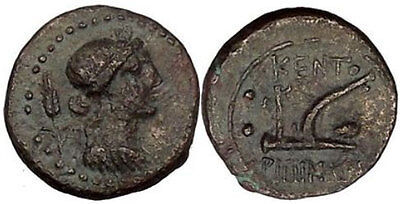
Kentoripai (Centuripae) in Sicily 211BC Ancient Greek Coin Demeter Plough i41811
Greek city of Kentoripai (Centuripae) in Sicily
Bronze Hexas 17mm (3.95 grams) Struck 211-200 B.C.
Reference: Sear 1084; B.M.C. 2.15; SNG Lloyd 928; Calciati 7; Campana 5
Bust of Demeter right, wreathed with corn; behind, tripod.
KENTOPIПINΩN, Plough right, bird right on the share; two pellets in field to left.

Kephaloidion in Sicily 344BC Ancient Greek Coin Pegasus winged horse i36972
Greek city of Kephaloidion in Sicily
Bronze 13mm (2.26 grams) Struck 344-336 B.C.
Reference: Calciati pg. 371, 3; SNG ANS -.
Head of Hercules right, wearing lion’s skin headdress.
Pegasus flying right.
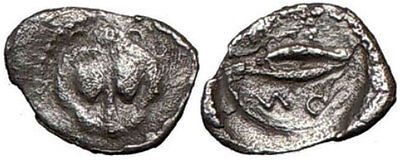
LEONTINOI in SICILY 475BC Lion Corn grain Ancient Silver Greek Coin i18500
Greek city of Leontinoi in Sicily
Silver Obol 12mm (0.49 grams) Struck 475-466 B.C.
Reference: Sear 828; B.M.C. 2.19
Lion’s head facing.
ΛEON – Corn-grain.
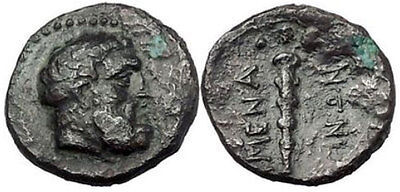
MENAINON in SICILY 2ndCenBC Hercules Club QUADRANS Ancient Greek Coin i46600
Greek city of Menainon in Sicily
Bronze Quadrans 17mm (2.64 grams) Struck late 2nd Century B.C.
Reference: HGC 2, 763; CNS III, pp. 188-189, nos. 12-12/6
Bearded head of Hercules right.
MENAINΩN, club; mark of value, three pellets below.
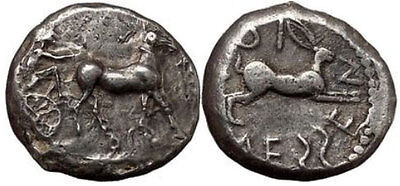
MESSANA in SICILY 480BC Tetradrachm Rare Silver Greek Coin Hare Chariot i40765
Greek city of Messana in Sicily
Silver Tetradrachm 26mm (17.38 grams) Struck circa 480-461 B.C.
Reference: SNG München 363 var.; Caccamo Caltabiani 218, 97 var.; Randazzo 59, 162 var.
Charioteer driving biga of mules right; leaf in exergue.
ΜΕSSΕ-N-ΙΟ-N, Hare springing right.
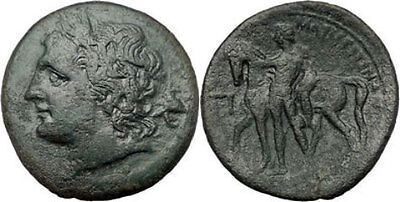
Messana in Sicily under Mamertini 220BC Greek Coin Ares Cult Dioskouros i46604
Greek city of Messana in Sicily
under the name of Mamertini “Sons of Mars”
Bronze Pentonkion 27mm (10.14 grams) Struck circa 220-200
Reference: Sear 1143; B.M.C. 2. 32
Laureate head of Ares left.
MAMEPTINΩN – Horseman (Dioskouros) standing left, holding spear and touching the head
of his horse standing left behind him; Π in field to left.

NAXOS in SICILY 461BC Silver Hexonkian Dionysus Kantharos Greek Coin i38811
Greek city of Naxos in Sicily
Silver Hexonkion – Hemilitron 8mm (0.18 grams) Struck circa 461-430 B.C.
Reference: Cahn 97 var. (V64/R– [unlisted rev. die]); Campana 12; Rizzo –; SNG ANS (Part 5) 1360 (same obv. die); SNG Lloyd –; SNG München –; Weber 618
Head of Dionysus right, wearing ivy wreath.
Kantharos; six pellets around (mark of value).
Very rare.
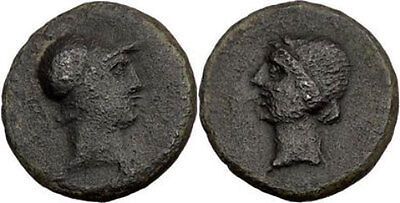
PANORMOS in SICILY 3rdCenBC Athena Persephone R1 Ancient Greek Coin i43658
Greek city of Panormos in Sicily
Bronze 23mm (9.99 grams) Struck late third-early second centuries B.C.
Reference: HGC 2, 1065 (R1); CNS I, pp. 331-332, nos. 12-12/6
ΠΑΝΟΡ/ΜΙΤΑΝ, Head of Athena in Corinthian helmet right.
Head of Persephone left, werated with grain.

PETRA in SICILY 340BC Zeus Aphrodite RARE Authentic Ancient Greek Coin i47250
Greek city of Petra in Sicily
Bronze 32mm (34.09 grams) struck circa 340-330 B.C.
Reference: HGC 2, 1097 (R2); CNS III, p.317, no. 1
ΠΕΤΡΙΝΩΝ, Head of bearded Zeus right.
Aphrodite enthroned right, holding dove.
Not much is known about the settlement, although it could be believed it was fortified as it’s name translates to “the Rock”. Numismatic evidence locates the city to have been located in the area of northwestern Sicily, and that it was founded before circa 350 B.C. The city gave itself over to Roman control in 254 B.C. during the First Punic War. The community survived until the second century A.D.
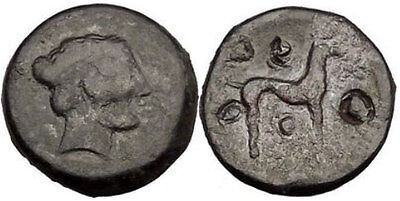
SEGESTA in SICILY 410BC Hound Dog Authentic Ancient Greek Coin i43985
Greek city of Segesta in Sicily
Bronze Triantes 19mm (7.95 grams) Struck 410-400 B.C.
Reference: HGC 2, 1181
Head of Aigiste right, wearing sphendone.
Hound standing right, four round punched value marks around.

Solus in Sicily 2ndCenBC Dolphin Tuna Fish Authentic Ancient Greek Coin i43653
Greek city of Solus in Sicily
Bronze 12mm (2.17 grams) Struck late second-early first centuries B.C.
Reference: HGC 2, 1269 (R3); CNS I, p. 312, no. 17
COΛΟΝ/ΤΙΝWΝ, dolphin leaping right.
Tuna swimming right.

Syracuse in Sicily 344BC Timoleon Ancient Greek Coin Athena Dolphins i46625
Greek city of Syracuse in Sicily
Time of Timoleon
Bronze Litra 30mm (31.71 grams) Struck 344-336 B.C.
Reference: Sear 1189; B.M.C. 2. 287
ΣΥΡΑ, Head of Athena left, wearing Corinthian helmet bound with olive-wreath.
Starfish between two dolphins.

Syracuse in Sicily AGATHOKLES 317BC Persephone Bull Dolphins Greek Coin i46589
Greek city of Syracuse in Sicily
Agathokles ( Agathocles)- Tyrant of Syracuse 317-289, King of Sicily 304-289 B.C.
Bronze 23mm (9.04 grams) Struck circa 317-310 B.C.
Reference: HGC 2, 1444
ΣYPAKOΣIΩN, Head of Persephone left, wreathed with grain; symbol behind.
Bull charging left; dolphin above and below; NK monogram above.

Syracuse Sicily 270BC King Hieron II Ancient Greek Coin Poseidon Trident i39151
Greek city of Syracuse in Sicily
Bronze 20mm (7.13 grams) under king Hieron II, 270-215 B.C.
Reference: Sear 1223; B.M.C. 2. 603
Head of Poseidon left, wearing tainia.
Ornamented trident-head, between two dolphins, dividing IEPΩ – NOΣ.
0 notes
Text
Morris Online Sale Part I Takes $215,704
The major rarities of the vast Morris Collection of Roman Imperial coins was sold by Heritage Auctions as part of their January 2019 NYINC sale. As announced at the time the remainder of the collection is to be sold through dedicated monthly internet auctions over the remainder of this year.
On May 26 Part I of the sale was completed with extremely satisfactory results. The 507 lots brought in $60,000 over the high estimate of $156,000 for a total of $215,704. Numerous unlisted varieties realized multiples of high estimate with sestertii being particularly active.
Top-selling gold: solidus of Leo V the Armenian, Emperor of the Byzantine Empire AD 813-820 (Sear 1627) that sold for $5,040 in NGC Choice AU 5/5 – 3/5 as part of Heritage Auctions on-line sale of the Morris Collection Part I. (Images courtesy and © Heritage Auctions.)
The top-priced gold item was a delightful 20 mm, 4.42 g solidus of Leo V the Armenian, Emperor of the Byzantine Empire AD 813-820 (Sear 1627). Struck at Constantinople the obverse shows Leo wearing crown and chlamys with cross potent in his right hand. The reverse has a bust of Constantine also with crown and chlamys. Graded a desirable NGC Choice AU 5/5 – 3/5, albeit with edge scuffs, it had no problem in selling for $5,040.
Top silver item was a superb 26 mm, 13.16 g 16 litrai of Syracuse struck for Philistis, wife of Hieron II, 275-215 BCE. The obverse shows the queen’s head veiled and diademed. The reverse has Nike driving a quadriga (HGC 2, 1556; SNG ANS 872-874). In NGC Choice AU 4/5 – 2/5 the lot realized $3,360.
Top-selling silver: 16 litrai of Syracuse struck for Philistis, wife of Hieron II, 275-215 BC, showing her head on the obverse. In NGC Choice AU 4/5 – 2/5 the coin took $3,360. (Images courtesy and © Heritage Auctions.)
While high grade and attractive examples stole the show the fifth highest selling item was a 30 mm, 25.30 g bronze Commodus sestertius struck at Rome in CE 186 and graded just NGC Choice Fine 4/5 – 2/5 (RIC III 487). Its price of $2,640 proves that even the modest preservation specimens are garnering attention if sufficiently rare and interesting.
The Commodus sestertius of AD 186 that achieved $2,640 despite just a NGC Choice Fine 4/5 – 2/5 grading. The laureate head of Commodus appears on the obverse with a galley and rowers on the reverse. (Images courtesy and © Heritage Auctions.)
Full catalog details and prices realized are available at
www.ha.com.
This article was originally printed in World Coin News. >> Subscribe today.
The post Morris Online Sale Part I Takes $215,704 appeared first on Numismatic News.
0 notes
Text

Que le Saint Esprit remplisse nos cœurs de joie, de paix et d'assurance,
Et enfin que Le Psaumes 108 soit notre partage au nom de Jésus.
" JE TRIOMPHERAI "
2 Mon cœur est tranquille, ô mon Dieu,
et ma gloire, c'est de te chanter, de te célébrer en musique!
3 Vite, éveillez-vous, luth et harpe !
Je veux éveiller l'aurore.
4 Je veux te louer, Éternel, au milieu des peuples,
et te célébrer en musique parmi les nations.
5 Ton amour s'élève plus haut que les cieux,
ta fidélité jusqu'aux nues!
6 O Dieu, manifeste ta grandeur au-dessus des cieux,
et ta gloire sur toute la terre,
7 pour la délivrance de ceux que tu aimes!
Sauve par ta droite, réponds-moi!
8 Dieu l'a déclaré dans son sanctuaire: «Je triompherai!
Je vais m'emparer de Sichem. Je vais mesurer au cordeau le val de Soukkoth.
9 A moi Galaad, à moi Manassé!
Ephraïm est un casque pour ma tête.
Mon sceptre royal, c'est Juda,
10 et, pour me laver, j'ai Moab.
Sur Edom, je jette ma sandale.
De la Philistie, je triomphe.»
11 Qui me mènera à la ville forte,
qui me conduira à Edom,
12 sinon toi, ô Dieu? Toi qui nous avais rejetés,
qui ne sortais plus avec nos armées, ô Dieu!
13 Viens nous secourir contre l'adversaire!
Car trompeur est le secours qui nous vient des hommes.
14 Mais avec Dieu nous ferons des exploits,
c'est lui qui écrasera tous nos adversaires.
Bonne méditation
La Parole de Dieu est profondément simple et simplement profonde.
Amen.
"MARANATHA"
Jésus Christ revient!!!
0 notes
Text
0 notes
Photo
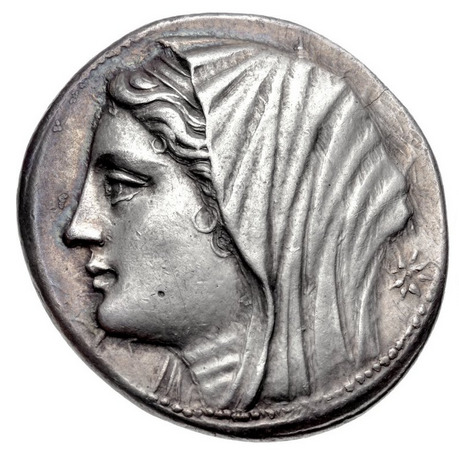
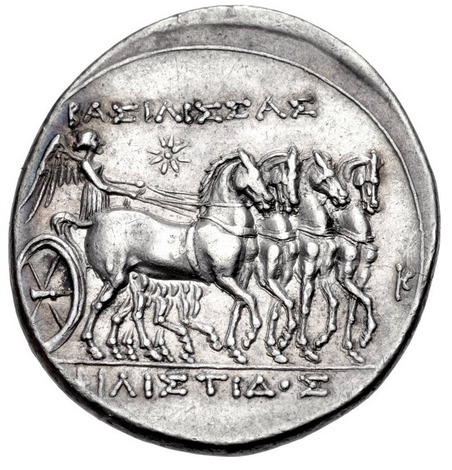
Tetradrachm of Philistis, wife of Hieron II, Syracuse, Sicily, struck c. 218/7-214 BC
The coin shows the diademed and veiled head of Philistis facing left with a star to her right. The reverse is inscribed with BAΣIΛIΣΣAΣ ΦIΛIΣTIΔOΣ (Basilissas Philistidos) and shows Nike, holding reins in both hands, driving a quadriga facing right; a star is above and a K to the right.
Philistis was a queen of ancient Syracuse, known only from her coins, which are numerous, and of fine workmanship, and from the occurrence of her name (bearing the title of queen, as it does also on her coins) in an inscription in large letters on the great theatre of Syracuse.
Hieron II was the Greek Sicilian king of Syracuse from 270 to 215 BC, and the illegitimate son of a Syracusan noble, Hierocles, who claimed descent from Gelon. He was a former general of Pyrrhus of Epirus and an important figure of the First Punic War. On the departure of Pyrrhus from Sicily (275 BC) the Syracusan army and citizens appointed him commander of the troops. He strengthened his position by marrying Philistis, the daughter of Leptines, the leading citizen.
#coins#philistis#hieron ii#syracuse#sicily#history#ancient#ancient coins#numismatics#tetradrachm#ancient history#greek coins#ancient greece#greek#greece#antiquities#art#treasure#3rd century bc#magna graecia#coin
214 notes
·
View notes
Photo

Étoile De Jésus Le Seigneur soit avec vous , Bonjour les amies (s), Soyez bénies (s) au nom de Jésus, Que le Saint Esprit remplisse nos cœurs de joie, de paix et d'assurance, Et enfin que Le Psaumes 108 soit notre partage au nom de Jésus. " JE TRIOMPHERAI " 2 Mon cœur est tranquille, ô mon Dieu, et ma gloire, c'est de te chanter, de te célébrer en musique! 3 Vite, éveillez-vous, luth et harpe ! Je veux éveiller l'aurore. 4 Je veux te louer, Éternel, au milieu des peuples, et te célébrer en musique parmi les nations. 5 Ton amour s'élève plus haut que les cieux, ta fidélité jusqu'aux nues! 6 O Dieu, manifeste ta grandeur au-dessus des cieux, et ta gloire sur toute la terre, 7 pour la délivrance de ceux que tu aimes! Sauve par ta droite, réponds-moi! 8 Dieu l'a déclaré dans son sanctuaire: «Je triompherai! Je vais m'emparer de Sichem. Je vais mesurer au cordeau le val de Soukkoth. 9 A moi Galaad, à moi Manassé! Ephraïm est un casque pour ma tête. Mon sceptre royal, c'est Juda, 10 et, pour me laver, j'ai Moab. Sur Edom, je jette ma sandale. De la Philistie, je triomphe.» 11 Qui me mènera à la ville forte, qui me conduira à Edom, 12 sinon toi, ô Dieu? Toi qui nous avais rejetés, qui ne sortais plus avec nos armées, ô Dieu! 13 Viens nous secourir contre l'adversaire! Car trompeur est le secours qui nous vient des hommes. 14 Mais avec Dieu nous ferons des exploits, c'est lui qui écrasera tous nos adversaires. Bonne méditation La Parole de Dieu est profondément simple et simplement profonde. Amen. "MARANATHA" Jésus Christ revient!!! https://www.instagram.com/p/CUS-jrVsyBI/?utm_medium=tumblr
0 notes
Text
l’Évangile au Quotidien
l’Évangile au Quotidien
« Seigneur, vers qui irions-nous ? Tu as les paroles de la vie éternelle » Jn 6, 68
Mardi 27 Avril
Livre des Actes des Apôtres 11,19-26.
En ces jours-là, les frères dispersés par la tourmente qui se produisit lors de l’affaire d’Étienne allèrent jusqu’en Phénicie, puis à Chypre et Antioche, sans annoncer la Parole à personne d’autre qu’aux Juifs.
Parmi eux, il y en avait qui étaient originaires de Chypre et de Cyrène, et qui, en arrivant à Antioche, s’adressaient aussi aux gens de langue grecque pour leur annoncer la Bonne Nouvelle : Jésus est le Seigneur.
La main du Seigneur était avec eux : un grand nombre de gens devinrent croyants et se tournèrent vers le Seigneur.
La nouvelle parvint aux oreilles de l’Église de Jérusalem, et l’on envoya Barnabé jusqu’à Antioche.
À son arrivée, voyant la grâce de Dieu à l’œuvre, il fut dans la joie. Il les exhortait tous à rester d’un cœur ferme attachés au Seigneur.
C’était en effet un homme de bien, rempli d’Esprit Saint et de foi. Une foule considérable s’attacha au Seigneur.
Barnabé partit alors à Tarse chercher Saul.
L’ayant trouvé, il l’amena à Antioche. Pendant toute une année, ils participèrent aux assemblées de l’Église, ils instruisirent une foule considérable. Et c’est à Antioche que, pour la première fois, les disciples reçurent le nom de « chrétiens ».
Psaume 87(86),1-3.4-5.6-7.
Elle est fondée sur les montagnes saintes.
Le Seigneur aime les portes de Sion
plus que toutes les demeures de Jacob.
Pour ta gloire on parle de toi, ville de Dieu !
« Je cite l'Égypte et Babylone
entre celles qui me connaissent. »
Voyez Tyr, la Philistie, l'Éthiopie :
chacune est née là-bas.
Mais on appelle Sion : « Ma mère ! »
car en elle, tout homme est né.
C'est lui, le Très-Haut, qui la maintient.
Au registre des peuples, le Seigneur écrit :
« Chacun est né là-bas. »
Tous ensemble ils dansent, et ils chantent :
« En toi, toutes nos sources ! »
Jean 10,22-30.
On célébrait la fête de la dédicace du Temple à Jérusalem. C’était l’hiver.
Jésus allait et venait dans le Temple, sous la colonnade de Salomon.
Les Juifs firent cercle autour de lui ; ils lui disaient : « Combien de temps vas-tu nous tenir en haleine ? Si c’est toi le Christ, dis-le nous ouvertement ! »
Jésus leur répondit : « Je vous l’ai dit, et vous ne croyez pas. Les œuvres que je fais, moi, au nom de mon Père, voilà ce qui me rend témoignage.
Mais vous, vous ne croyez pas, parce que vous n’êtes pas de mes brebis.
Mes brebis écoutent ma voix ; moi, je les connais, et elles me suivent.
Je leur donne la vie éternelle : jamais elles ne périront, et personne ne les arrachera de ma main.
Mon Père, qui me les a données, est plus grand que tout, et personne ne peut les arracher de la main du Père.
Le Père et moi, nous sommes UN. »
- © AELF, Paris
« Le Père et moi, nous sommes UN »
Envoyé et sorti du Père, le Verbe est descendu
et il a habité tout entier dans les entrailles de la Vierge.
Tout entier il était dans le Père,
et tout entier il était dans ce sein virginal,
et tout entier dans le tout, lui que rien ne peut contenir. (...)
Demeurant inchangé, il a pris la forme d'esclave (Ph 2,7)
et après avoir été mis au monde, il est devenu un homme en tout. (...)
Comment affirmer ce qui est impossible à expliquer
à tous les anges, aux archanges et à tout être créé ?
On le pense d'une manière véritable,
mais on ne peut pas du tout l'exprimer,
et notre esprit ne peut pas le comprendre vraiment parfaitement.
Comment donc Dieu et homme, et homme-Dieu
est-il aussi le Fils du Père, tout entier,
d'une manière qui ne l'en sépare pas ;
comment est-il devenu fils de la Vierge et est-il sorti dans le monde ;
et comment est-il resté impossible à contenir pour tous ? (...)
Tu resteras silencieux maintenant
car même si tu voulais parler, ton esprit ne trouvera pas de parole,
et ta langue bavarde demeure réduite au silence. (...)
Gloire à toi, Père et Fils et Esprit Saint,
divinité que l'on ne peut pas saisir, indivisible dans sa nature.
Nous t'adorons dans l'Esprit Saint,
nous qui possédons ton Esprit, car nous l'avons reçu de toi.
Et, voyant ta gloire, nous ne recherchons pas indiscrètement,
mais c'est en lui, ton Esprit, que nous te voyons,
Père inengendré, et ton Verbe engendré qui sort de toi.
Et nous adorons la Trinité indivisible et sans mélange
dans son unique divinité et souveraineté et puissance.
https://www.christian.art/todays-reading.php
0 notes
Video
youtube
The Biblical story of the Tabernacle at Shiloh. (Joshua 18-Samuel 10)
--> Film projeté avant d’entrer sur le site retraçant les 12 tribus d’Israël (en anglais) ♥ ♥ ♥
--> A regarder en mode “Full screen” car filmé en panoramique puis projection à 180° en transparence sur les collines du lieu.

Lire aussi : Silho, lieu du Tabernacle d’Elohim pendant 369 ans
Le Tabernacle a été reconstruit à l’identique dans le Néguev et peut être visité à TIMNA PARK (Vidéo)
Silo ou Siloh (en hébreu : šīloh, שילה, de la racine š-'-l, signifiant « lieu où l'on demande des oracles ») est un des plus importants lieux de culte d'Israël pendant la période des Juges.
Selon la Bible, il est situé au centre de la Samarie, au sud de Tirtza, l'ancienne capitale du royaume d'Israël. Il est détruit en 1050 av. J.-C. lors d'une bataille opposant les Philistins aux Hébreux.
La première mention de Silo se trouve dans le Livre de Josué, c'est à cet endroit que les Israélites se répartissent les territoires qu'ils devront conquérir et occuper par la suite. Les villes refuges et les cités pour les lévites sont également attribuées depuis Silo. Ce lieu devient le lieu de culte principal et de gouvernement, l'endroit où les fils d'Israël se retrouvent pour les fêtes annuelles à l'époque des Juges.
Le Tabernacle et l'Arche d'Alliance y sont placés pendant 369 ans.
Le Tabernacle quitte Silo à la mort d’Eli.
À un moment durant son séjour, le tabernacle est remplacé par ou placé dans une structure, précurseur du temple (1 Samuel 3:15).
Eli instruit Samuel à Silo. Ce dernier prophétise et sert dans le tabernacle, mais pas comme un lévite car il n'est pas descendant d'Aaron.
Lorsque les Philistins battent les Israélites à Afek vers 1050 av J.C., une partie des Philistins emmène l'Arche en Philistie à Ashdod pendant qu'une autre partie marche sur Silo et détruit le sanctuaire. Selon les données archéologiques, la destruction du sanctuaire coïncide avec celle de la ville.
Cette destruction a un fort impact sur le peuple d'Israël, elle est citée plusieurs fois dans la Bible hébraïque (Psaume 78,60, Jérémie 7,12). Le tabernacle est enlevé et transporté à Gibeon où il reste jusqu'au règne du roi Salomon. L'arche est rapidement rendue aux Israélites. Elle est alors conservée à Kiryat-Yéarim jusqu'au règne du roi David.
Le site est déserté, puis réoccupé pendant le règne de Jéroboam. Il est toujours mentionné à l'époque de la destruction du Temple.
Vidéo des fouilles archéologiques à Shiloh
vimeo
0 notes